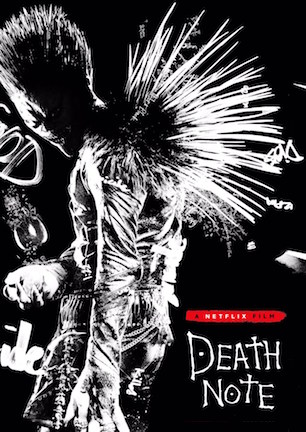Studio: Netflix
Director: Adam Wingard
Writer: Charles Palapanides, Vlas Palapanides, Jeremy Slater
Producer: Roy Lee, Dan Lin, Masi Oka, Jason Hoffs, Ted Sarandos
Stars: Nat Wolff, Lakeith Stanfield, Margaret Qualley, Shea Whigham, Paul Nakauchi, Jason Liles, Willem Dafoe
Review Score:
Summary:
A troubled teen comes into possession of a mysterious book with the power to kill anyone whose name is written in its pages.
Review:
“Death Note” tells a tale involving Seattle high school student Light Turner, who mysteriously comes into possession of an even more mysterious book. The ‘Death Note’ contains countless pages explaining the rules of how it works. The most important rule is the first one, which states that anyone whose name is written in the book will die.
Possession of this terrible tome comes with the ability to see Ryuk, a mischievous death demon who resembles something of a malformed leprechaun mixed with a monstrous porcupine. Ryuk demonstrates the Death Note’s power by convincing a disbelieving Light to murder the school bully using any method of choice. Light inks “decapitation” next to the name, setting off a spectacular chain of events ending in the bully’s head leaving his neck and Light’s jaw hitting the floor.
Light then does what any teenager would do in his situation. He tries impressing his love interest Mia by letting her in on the secret of what the Death Note does. Together, the deadly duo embarks on a Dexter-like crusade of remotely executing Death Row inmates and high profile terrorists worldwide. By pinning the deaths on an imaginary entity named ‘Kira,’ Mia and Light create a vengeful vigilante god whom everyone seemingly adores.
Everyone except L, that is. Raised from birth to be an unusually elite detective, L has a sneaking suspicion that Kira comes from Seattle. Making matters worse for Light, L’s hunt for the truth leads him to partner with the city’s lead investigator on the case, who happens to be Light’s father. As if wielding the Death Note’s destructiveness was not enough of a burden, Mia and Light now have to stay one step ahead of law enforcement and a malevolent demon before things truly spiral out of control.
Adam Wingard’s Netflix movie is my first exposure to the world of “Death Note,” which spans a multi-volume manga (by Tsugumi Ohba and Takeshi Obata), an anime series, a light novel, video games, several live-action Japanese language films, a TV program, and even a musical. Level of familiarity with a beloved transmedia property can be an important distinction to make when discussing any adaptation. Because certain camps of longtime fans often come at new takes with pitchforks sharpened and torches blazing, anxious to bemoan what was changed, what stayed the same, or what wasn’t done “right.”
Consider this my declaration that I have no dog in any fight over how faithful this version is or isn’t to its source material. Coming at it as a standalone story, Wingard’s “Death Note” is wickedly imaginative, with razor-sharp visuals, slick scenes of sinister slaughter, pulse-pounding intensity, and several eccentric characters who put some slyness in the spirit.
Alliterative hyperbole aside, as a neophyte to this narrative, “Death Note” makes me want to track down the original manga, movies, and anime to delve deeper into the richly detailed fiction. This speaks to Wingard’s sincere success at inspiring audiences to make additional investments in a broader universe.
“Death Note” darkens its mood using David Tattersall’s camera and Tom Hammock’s production design. Colored lights rip through rain-soaked sets or put halos around silhouettes for a look that is concurrently bright and bleak. It’s an outward exemplification of how “Death Note” often offers imbalanced tones, though the resulting style is undeniably cinematic.
“Death Note” alternately lightens itself through colorful personalities. Lakeith Stanfield flirts with putting too much quirk into enigmatic investigator L, although each deliberately over-thought mannerism adds intriguing layers that don’t necessarily come from the script. Willem Dafoe similarly tiptoes on a tightrope between terrifying and cartoonish. But the bite he puts into Ryuk using only his voice imbues the devil with an impish menace full of frightful fun.
The movie’s Achilles Heel lies in Mia and Light not having anywhere near the same charm as the antagonists. Their fizzled chemistry also writes their romance on page one of the Death Note. If Light were more likable, “Death Note” would be too. This is the unfortunate elephant that actor Nat Wolff never moves out of the room.
Light isn’t motivated by misguided angst. Light is driven by spiteful smugness, a quality that quickly chills his appeal as a person. Everyone around Light is infinitely more interesting and when Light becomes the center of a scene, energy disappears in a vacuum. His off-putting attitude is enough to make a vicarious experience undesirable.
Mia follows suit by cooling into a black widow before ever heating up as a cute romantic interest. Getting behind her and Light as a couple becomes impossible given the questionable circumstances of their quick courtship.
Divorce yourself from the drama of problematic protagonists, an admittedly tall order, and getting into the swing of “Death Note’s” more entertaining elements is easier. Others have argued that Adam Wingard’s eclectic blend of horror, police procedural, family soap opera, and comic book spectacle contains too many ingredients for a reasonable meal. I’d counter that the creative mix makes a uniquely enjoyable experience out of uniquely inventive ideas.
Maybe this isn’t the “Death Note” that diehards desire. But maybe it’s the “Death Note” that makes the most sense for the mainstream.
Review Score: 75






It assumes everyone watching must be a dimwit too dense to understand how the most basic storytelling concepts work.